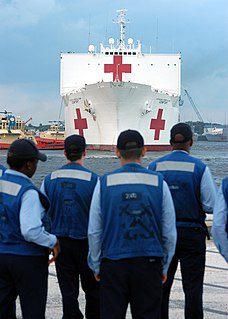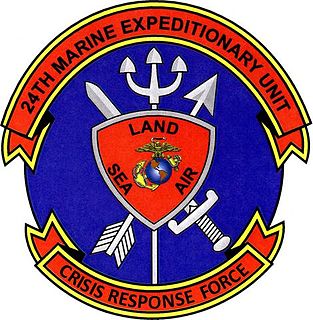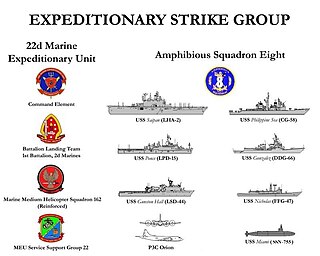
The Battle of Iwo Jima was a major battle in which the United States Marine Corps landed on and eventually captured the island of Iwo Jima from the Imperial Japanese Army (IJA) during World War II. The American invasion, designated Operation Detachment, had the goal of capturing the entire island, including the three Japanese-controlled airfields, to provide a staging area for attacks on the Japanese main islands. This five-week battle comprised some of the fiercest and bloodiest fighting of the Pacific War of World War II.

Iwo To, known in English as Iwo Jima, is one of the Japanese Volcano Islands and lies south of the Bonin Islands. Together with other islands, they form the Ogasawara Archipelago. The highest point of Iwo Jima is Mount Suribachi at 169 m (554 ft) high.

USS Bonhomme Richard (LHD-6) is a Wasp-class amphibious assault ship, and the third ship of the United States Navy to bear the name. She was named in honor of John Paul Jones' famous frigate, which he had named in French "Good Man Richard," in honor of Benjamin Franklin, the U.S. Ambassador to France at the time; "Richard" is derived from Franklin's Poor Richard's Almanac.

USS Shreveport (LPD-12) is an Austin-class American amphibious transport dock. It is the second ship of the United States Navy to be named for the city in Louisiana. Her keel was laid down on 27 December 1965 by the Lockheed Shipbuilding and Construction Company of Seattle, Washington. She was launched on 22 October 1966 sponsored by Mrs. Andrew McBurney Jackson, Jr., and commissioned on 12 December 1970 with Captain Pehr H. Pehrsson in command.

USS Iwo Jima (LHD-7) is a Wasp-class amphibious assault ship of the United States Navy. The ship was named for the Battle of Iwo Jima of World War II. The ship was commissioned in 2001 and is currently in service.

USS New Orleans (LPH-11) was an Iwo Jima-class amphibious assault ship in the United States Navy. She was the third Navy ship to be so named, and is the first named for the Battle of New Orleans, which was the last major battle of the War of 1812.
A Sea Service Ribbon is an award of the United States Navy, U.S. Marine Corps, U.S. Coast Guard, the U.S. Army, and the NOAA Commissioned Officer Corps which recognizes those service members who have performed military duty while stationed on a United States Navy, Coast Guard, Army, or NOAA vessel at sea and/or members of the Navy, Marine Corps or Coast Guard who have been forward-deployed with their home unit.
The Fleet Marine Force Warfare Insignia, also known as the Fleet Marine Force badge or FMF pin, are three military badges of the United States Navy which are issued to those U.S. Navy officers and sailors who are trained and qualified to perform duties in support of the United States Marine Corps. There are currently three classes of the Fleet Marine Force pin, being that of enlisted, officer, and chaplain.

The Dental Corps of the United States Navy consists of naval officers who have a doctorate in either dental surgery (DDS) or dental medicine (DMD) and who practice dentistry for Sailors and Marines to ensure optimal oral health.

Joint Task Force Katrina was a joint operation between the United States Department of Defense and the Federal Emergency Management Agency created on September 1, 2005 at Camp Shelby, Mississippi to organize relief efforts along the Gulf Coast in the aftermath of Hurricane Katrina. The operation was headed by U.S. Army Lieutenant General Russel L. Honoré. Joint Task Force Katrina took over operations from United States Northern Command that had some elements in place before Hurricane Katrina struck the Gulf Coast.

The 24th Marine Expeditionary Unit is one of seven Marine Expeditionary Units currently in existence in the United States Marine Corps. The Marine Expeditionary Unit is a Marine Air Ground Task Force (MAGTF) with a strength of about 2,200 personnel. The MEU consists of a Command Element, a Ground Combat Element based on a reinforced infantry battalion, an Aviation Combat Element based on a reinforced tiltrotor squadron, and a Logistics Command Element based on a Combat Logistics Battalion. The 24th MEU is currently based out of Marine Corps Base Camp Lejeune, North Carolina.

USS Dunlap (DD–384) was a Mahan-class destroyer in the United States Navy before and during World War II. She was named after Brigadier General Robert H. Dunlap, USMC. In some references she is listed as a Dunlap-class destroyer. Captain was Clifton Iverson, who earned the Naval Cross during Vella Gulf battle.

USS Fanning (DD-385) was a Mahan-class destroyer, in the United States Navy named for Nathaniel Fanning. Her first action was during World War II, immediately following the 7 December 1941 attack on Pearl Harbor. Fanning continued to serve in the Pacific Theatre throughout the war, and was decommissioned 14 December 1945. She was one of the last Mahan-class destroyers. Fanning and USS Dunlap were built from the same basic Mahan design but slightly modified. Some sources refer to them as the Dunlap-class destroyers.

USS Gatling (DD-671) was a Fletcher-class destroyer of the United States Navy, named after Richard Jordan Gatling, the inventor of the Gatling gun.

USS Rooks (DD-804) was a Fletcher-class destroyer of the United States Navy, named for Captain Albert H. Rooks (1891–1942) who was posthumously awarded the Medal of Honor after the Battle of Sunda Strait.

The Battle Effectiveness Award, is awarded annually to the small number of United States Navy ships, submarines, aviation, and other units that win their battle effectiveness competition.

The expeditionary strike group (ESG) is a United States Navy concept introduced in the early 1990s, based on the Naval Expeditionary Task Force. The U.S. Navy fields nine expeditionary strike groups and ten carrier strike groups, in addition to surface action groups. ESGs allow the U.S. to provide highly movable and self-sustaining naval forces for missions in various parts of the world.

USS San Bernardino (LST-1189) was the eleventh of twenty Newport-class tank landing ships built for the United States Navy in the late 1960s and early 1970s. Named after the City of San Bernardino, California, she was the second U.S. Naval vessel to bear the name.
USS LST-70 was an LST-1-class tank landing ship in the United States Navy. Like many of her class, she was not named and is properly referred to by her hull designation. LST-70 was manned by a United States Coast Guard crew throughout the war.

The 414th Fighter Group is an Air Reserve Component (ARC) of the United States Air Force. It is assigned to the 944th Fighter Wing of Tenth Air Force, Air Force Reserve Command, stationed at Seymour Johnson Air Force Base, North Carolina.

















